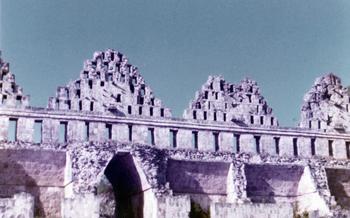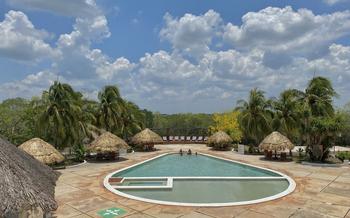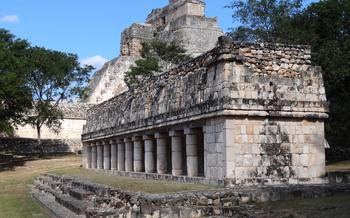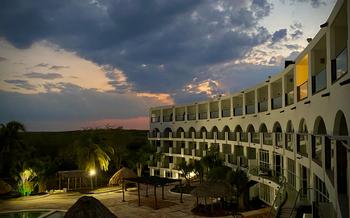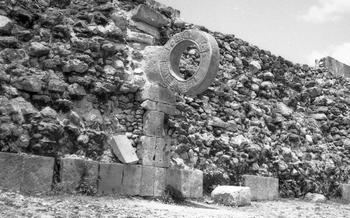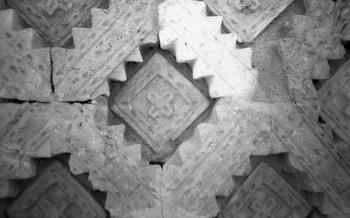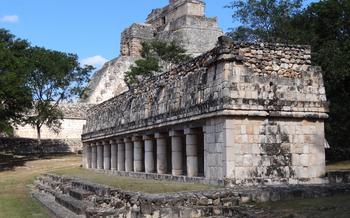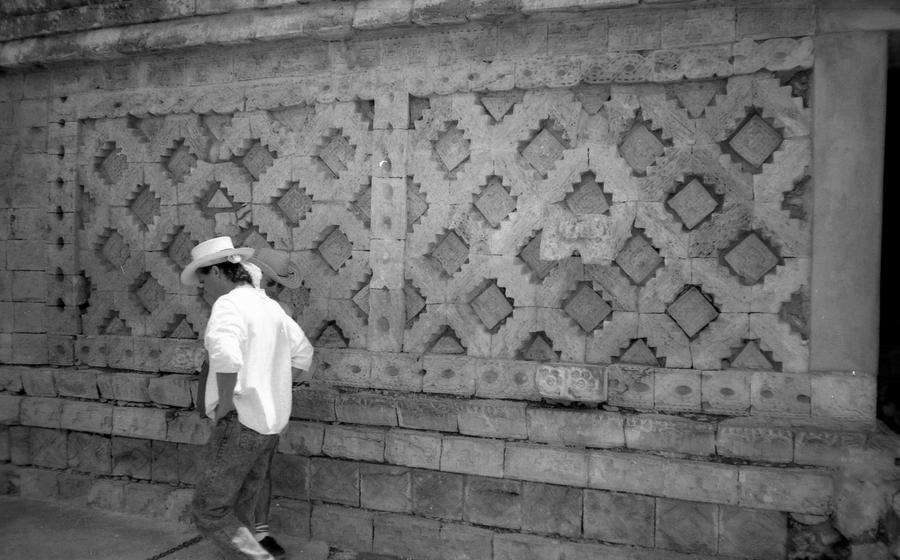
Temple of the Alamo
- The Temple of the Alamo: A Masterpiece of Mayan Architecture
- Exploring the Temple's Intricate Details
- Unveiling the Ancient Mayan Ball Court
- Admire the Impressive Nunnery Quadrangle
- Discover the Governor's Palace Complex
- Explore the Grand Pyramid
- Visit the House of the Turtles
- Wander Through the Residential Areas
- Immerse Yourself in the Local Culture
- Witness the Magic of the Light and Sound Show
- Combine Your Visit with Nearby Attractions
- Transportation Options to Reach Uxmal
- Plan Your Stay in Uxmal
- Insider Tip: Capture the Best Photos of the Temple of the Alamo
The Temple of the Alamo: A Masterpiece of Mayan Architecture
The Temple of the Alamo stands as a testament to the exceptional architectural prowess of the ancient Mayans. Its unique features set it apart from other structures within Uxmal and make it a must-see for visitors. The temple's most distinctive characteristic is its elaborately decorated facade, featuring intricate carvings and sculptures that depict various deities, mythical creatures, and scenes from Mayan mythology. These carvings provide a glimpse into the religious beliefs and artistic traditions of the ancient Maya.
The temple's name, "Alamo," is derived from the Spanish word for "poplar," a tree commonly found in the region. The Mayans, however, referred to the temple as "Kab-ul," meaning "the hand of the lord." This name is believed to be a reference to the temple's association with the Mayan god Itzamna, who was often depicted with a hand emerging from his mouth.
Visitors to the Temple of the Alamo can choose to explore the structure on their own or join a guided tour. Guided tours offer valuable insights into the temple's history, symbolism, and architectural features, enhancing the overall experience. Whether exploring independently or with a guide, the Temple of the Alamo is sure to captivate and inspire visitors with its grandeur and intricate details.
Exploring the Temple's Intricate Details
The Temple of the Alamo boasts a wealth of intricate carvings and sculptures that narrate the stories and beliefs of the ancient Mayans. As you ascend the temple's steps, marvel at the elaborate facades adorned with representations of deities, mythical creatures, and scenes from Mayan mythology. Each carving is a testament to the skill and artistry of the Mayan craftsmen.
One of the most striking features of the temple is the series of Chac masks that adorn the upper facade. These masks represent the rain god, Chac, who was revered by the Mayans for his ability to bring life-giving rain to their crops. The masks are characterized by their long, drooping noses and prominent fangs, which symbolize the power of Chac to control the elements.
Another significant architectural element is the corbel arch, which forms the entrance to the temple's inner sanctum. The corbel arch is created by stacking layers of stone blocks in a gradually inward-sloping manner, without the use of any mortar or cement. This engineering feat demonstrates the advanced architectural prowess of the Mayans and their ability to create stable and durable structures without the use of modern construction techniques.
Finally, the view from the top of the temple is simply breathtaking. From this vantage point, you can survey the entire archaeological site, with the lush green jungle canopy stretching out before you. The surrounding pyramids, temples, and plazas create a mesmerizing panorama that transports you back in time, allowing you to imagine the grandeur and splendor of ancient Uxmal.
Unveiling the Ancient Mayan Ball Court
At the heart of Uxmal lies a testament to the Mayans' prowess in sports and entertainment: the ancient ball court. This impressive structure, measuring 96 meters long and 30 meters wide, is a marvel of engineering and acoustics.
The Mayan ball game, known as pok-ta-pok, was a ritualistic sport deeply embedded in Mayan culture. It involved two teams of players who used their hips, shoulders, and elbows to propel a solid rubber ball through a stone hoop suspended high on the walls of the court.
The ball court's acoustics are truly remarkable. The sloping walls and strategically placed stones create an echo effect that amplifies the sound of the ball hitting the walls, creating an atmosphere of excitement and drama. This acoustic phenomenon enhances the game's intensity and adds to the overall spectacle.
Beyond its sporting significance, the ball court held profound cultural and religious importance for the Mayans. It was a sacred space where rituals and ceremonies took place, and the outcome of the game was believed to have implications for the community's well-being and agricultural prosperity.
Admire the Impressive Nunnery Quadrangle
Amidst the sprawling ruins of Uxmal, the Nunnery Quadrangle stands as a testament to the architectural prowess and cultural significance of the ancient Mayans. This grand complex, composed of four interconnected buildings surrounding a central courtyard, invites visitors to delve into the mysteries of its past.
The Nunnery Quadrangle derives its name from the Spanish conquistadors, who mistakenly believed that the complex served as living quarters for nuns. In reality, the quadrangle likely functioned as an administrative and ceremonial center, housing important officials and conducting religious rituals.
The most striking feature of the Nunnery Quadrangle is its intricate carvings and decorations. The facades of the buildings are adorned with elaborate geometric patterns, human figures, and representations of animals, each imbued with symbolic meaning. These carvings provide a glimpse into the worldview of the ancient Mayans, their beliefs, and their connection to the natural world.
The central courtyard of the quadrangle is an awe-inspiring sight, with its expansive dimensions and the surrounding buildings creating a sense of grandeur. The courtyard was likely used for gatherings, ceremonies, and other important events, serving as a focal point for the community.
Exploring the Nunnery Quadrangle is a journey through time, allowing visitors to connect with the ancient Mayans and their rich cultural heritage. The intricate carvings, the imposing architecture, and the enigmatic atmosphere combine to create a truly unforgettable experience.
Discover the Governor's Palace Complex
The Governor's Palace Complex stands as a testament to the architectural prowess and political significance of the ancient Maya. This imposing structure, located in the heart of Uxmal, once served as the administrative and residential center for the city's elite.
Its architectural design showcases the classic Puuc style, characterized by intricate carvings, corbel arches, and elaborate facades. The palace boasts a series of interconnected rooms and courtyards, each serving a specific function in the daily life of the ruling class.
The most striking feature of the Governor's Palace is its impressive facade, adorned with a multitude of decorative elements. The intricate carvings depict scenes from Mayan mythology, historical events, and everyday life, providing a glimpse into the rich cultural heritage of this ancient civilization.
The palace's interior spaces offer further insights into the lives of the Mayan rulers. The walls are adorned with colorful murals and friezes, depicting scenes of rituals, ceremonies, and battles. These artworks provide a vivid narrative of the power and influence wielded by the Mayan elite.
The Governor's Palace Complex is a must-see for anyone interested in understanding the political and administrative systems of the ancient Maya. Its impressive architecture and intricate carvings offer a glimpse into the lives of the rulers who once governed this thriving city-state.
Explore the Grand Pyramid
The Grand Pyramid: A Majestic Symbol of Power and Prestige
Uxmal's Grand Pyramid, also known as the Pyramid of the Magician, stands as a testament to the Mayans' architectural prowess and engineering skills. Towering at an impressive height of 115 feet, it is the tallest structure in Uxmal and one of the most significant in the entire Mayan world.
Constructed from massive limestone blocks, the pyramid exhibits a remarkable level of precision and symmetry. Its four sides are adorned with intricate carvings, depicting various deities, mythical creatures, and historical events. The pyramid's base measures approximately 200 feet by 180 feet, forming a massive platform upon which the temple at its summit was built.
Climbing the Grand Pyramid is a challenging yet rewarding experience, offering breathtaking panoramic views of the surrounding landscape. The ascent involves navigating steep staircases and narrow passageways, but the effort is well worth it for the stunning vistas that await at the top.
Once at the summit, visitors can explore the remains of the temple that once crowned the pyramid. Although in ruins, the temple's intricate carvings and decorations provide a glimpse into the artistic and religious significance of this ancient structure.
The Grand Pyramid holds a special place in Mayan history and mythology. According to legend, it was built by a powerful sorcerer or magician in a single night. While the historical accuracy of this tale is uncertain, it adds to the mystique and allure of this iconic pyramid.
Visit the House of the Turtles
Amidst the grandeur of Uxmal's ruins, the House of the Turtles stands out with its unique charm and captivating design. Named for the intricate turtle carvings adorning its facade, this structure holds a special place in Mayan culture.
The House of the Turtles is a testament to the Mayans' reverence for nature and their deep connection to the animal kingdom. The turtle, considered a symbol of fertility, longevity, and wisdom, was highly revered in Mayan mythology. Its presence on this building suggests that it may have served as a sacred space or a place of great importance in Mayan society.
The carvings on the facade showcase the Mayans' exceptional artistry and craftsmanship. Each turtle is meticulously carved, displaying a range of expressions and postures. The turtles seem to emerge from the building's walls, creating a dynamic and visually engaging effect.
Although the exact purpose of the House of the Turtles remains unknown, scholars believe it may have been used for various purposes. It could have served as a temple, a residence for high-ranking officials, or a meeting place for religious or political gatherings.
Today, the House of the Turtles stands as a testament to the ingenuity and artistry of the ancient Mayans. Its unique design and captivating carvings continue to captivate visitors, offering a glimpse into the rich symbolism and beliefs of this ancient civilization.
Wander Through the Residential Areas
Beyond the ceremonial and administrative centers, Uxmal also offers a glimpse into the domestic life of the ancient Mayans. The residential areas, located on the outskirts of the main ruins, provide a fascinating insight into the daily lives and customs of the people who once inhabited this vibrant city.
As you stroll through these neighborhoods, you'll notice the distinct layout and organization of the houses. Arranged in clusters, the residences were typically built on raised platforms, with walls constructed using a combination of stone and perishable materials like wood and thatch. The construction techniques employed showcase the Mayans' ingenuity and adaptability to the local environment.
Each house consisted of several rooms, each serving a specific purpose. There were sleeping quarters, kitchens, storage areas, and even workshops where artisans crafted their goods. The homes were often decorated with intricate carvings and paintings, reflecting the artistic prowess of the Mayans and their deep connection to their surroundings.
Wandering through Uxmal's residential areas is like stepping back in time, offering a rare opportunity to connect with the daily lives of the ancient Mayans. It's a chance to imagine the hustle and bustle of the city, the sounds of people going about their daily routines, and the laughter of children playing in the streets.
So, as you explore the magnificent temples and palaces of Uxmal, don't forget to venture into the residential areas and discover the hidden stories of the ordinary people who made this ancient city thrive.
Immerse Yourself in the Local Culture
Uxmal is not just about ancient ruins and historical wonders; it's also a place where you can immerse yourself in the vibrant local culture. Take advantage of your visit to experience the rich traditions and warm hospitality of the Yucatecan people.
Attend traditional Mayan ceremonies and rituals to witness the living heritage of the ancient Maya. These events offer a glimpse into the spiritual beliefs and practices that have been passed down through generations.
Visit local markets and shops for souvenirs that showcase the region's unique crafts and artistry. From intricate textiles to colorful pottery, you'll find a treasure trove of handmade items that make for perfect keepsakes or gifts.
Sample the delicious Yucatecan cuisine, renowned for its bold flavors and use of fresh, local ingredients. Indulge in mouthwatering dishes like cochinita pibil, a slow-cooked pork dish, or panuchos, a traditional stuffed tortilla.
Engage with the friendly local people and learn about their way of life. Strike up conversations, ask questions, and embrace the opportunity to connect with the warm and welcoming community of Uxmal.
Witness the Magic of the Light and Sound Show
As darkness descends upon the ancient city of Uxmal, a captivating spectacle unfolds, immersing visitors in a mesmerizing journey through time. The light and sound show, a relatively recent addition to the site, has quickly become a must-see experience for those seeking a deeper connection with the Mayan culture.
With state-of-the-art technology, the show transforms the ruins into a canvas of light and sound, bringing the history of Uxmal to life in a vibrant and unforgettable way. As the night sky serves as a backdrop, the ruins are illuminated with colorful projections, highlighting their intricate details and architectural wonders.
The show's captivating storytelling takes viewers on a journey through the rise and fall of the Mayan civilization, showcasing their achievements, beliefs, and daily lives. Through a blend of music, sound effects, and narration, visitors are transported back in time, experiencing the grandeur of Uxmal in its heyday.
Practical information: The light and sound show is typically held after dark, with showtimes varying depending on the season. Ticket prices are affordable, making it accessible to all visitors. To ensure a memorable experience, arrive early to secure a good viewing spot and immerse yourself in the magic of Uxmal's nocturnal spectacle.
Combine Your Visit with Nearby Attractions
Uxmal's allure extends beyond its own captivating ruins. Take advantage of its strategic location to discover other fascinating destinations in the region. Just a short drive away, you'll find the ancient Mayan cities of Kabah and Sayil, each boasting unique architectural wonders. Immerse yourself in their rich history and marvel at the intricate carvings that adorn their temples and palaces.
Venture further to the colonial gem of Merida, the vibrant capital of Yucatan. Stroll along its colorful streets, admire the grand colonial mansions, and soak in the lively atmosphere. Don't miss the opportunity to visit the impressive Merida Cathedral, a testament to Spanish colonial architecture.
For a refreshing dip, head to the nearby cenotes, natural swimming holes formed by the collapse of underground caves. Take a refreshing plunge into the crystal-clear waters and admire the stunning rock formations that surround these hidden oases.
If you crave a vibrant nightlife scene, Cancun and Playa del Carmen, two popular tourist destinations on the Caribbean coast, are within easy reach. Dance the night away at lively clubs, indulge in delicious seafood delicacies, and soak up the infectious energy that these coastal cities exude.
Transportation Options to Reach Uxmal
Reaching the ancient city of Uxmal is a journey that offers multiple transportation options, each catering to different preferences and budgets.
For those seeking the freedom to explore at their own pace, renting a car is an excellent choice. The flexibility of having your own vehicle allows you to set your own itinerary and make spontaneous stops along the way. However, it's important to consider the cost of renting a car, as well as the need for a valid driver's license and international driving permit.
If you prefer a more hassle-free experience, joining an organized tour might be the ideal option. These tours typically include transportation to and from your hotel, as well as the services of a knowledgeable guide who can provide insights into the history and significance of Uxmal. Organized tours offer a convenient and informative way to explore the ruins, but they may come with a higher price tag and less flexibility compared to renting a car.
For budget-conscious travelers, taking a local bus or taxi is a viable alternative. Buses depart regularly from the nearby city of Merida, and the journey takes approximately 1 hour and 30 minutes. Taxis offer a more direct and comfortable option but can be more expensive than buses. It's advisable to agree on a fare before getting into a taxi to avoid any misunderstandings.
No matter which transportation option you choose, make sure to plan your journey in advance, especially if you're visiting during peak season. It's always a good idea to research bus schedules, check car rental availability, or book a tour in advance to avoid any last-minute surprises.
Plan Your Stay in Uxmal
To fully appreciate the wonders of Uxmal, consider staying overnight near the ruins. Several charming hotels and guesthouses offer a range of options, from budget-friendly hostels to luxurious haciendas. Immerse yourself in the Mayan culture and opt for a hotel that incorporates traditional Mayan elements into its design and architecture.
For a truly memorable dining experience, savor the flavors of Yucatecan cuisine at one of the local restaurants. Indulge in dishes like cochinita pibil, panuchos, and papadzules, which showcase the region's unique culinary heritage. Be sure to try the refreshing local beer or a glass of handcrafted mezcal to complement your meal.
When packing for your trip, include comfortable shoes for navigating the uneven terrain, light clothing suitable for the warm climate, and a hat or scarf to protect yourself from the sun. Don't forget your camera to capture the stunning beauty of Uxmal, and consider bringing binoculars to enhance your wildlife viewing experiences.
Uxmal is generally a safe destination, but as with any travel destination, it's essential to take precautions. Be aware of your surroundings, avoid walking alone at night, and keep your valuables secure. If you have any concerns, don't hesitate to ask for assistance from your hotel staff or local authorities.
Insider Tip: Capture the Best Photos of the Temple of the Alamo
To capture the grandeur of the Temple of the Alamo, plan your visit during the golden hours, around sunrise or sunset, when the soft light illuminates the intricate details of the temple's facade. Use a wide-angle lens to capture the temple's full height and incorporate the surrounding lush vegetation for a sense of scale. Experiment with different angles and perspectives to create dynamic compositions. Don't miss the opportunity to climb to the top of the temple for breathtaking panoramic views, providing a unique perspective for capturing the surrounding ruins and the vast expanse of the Yucatan jungle.

